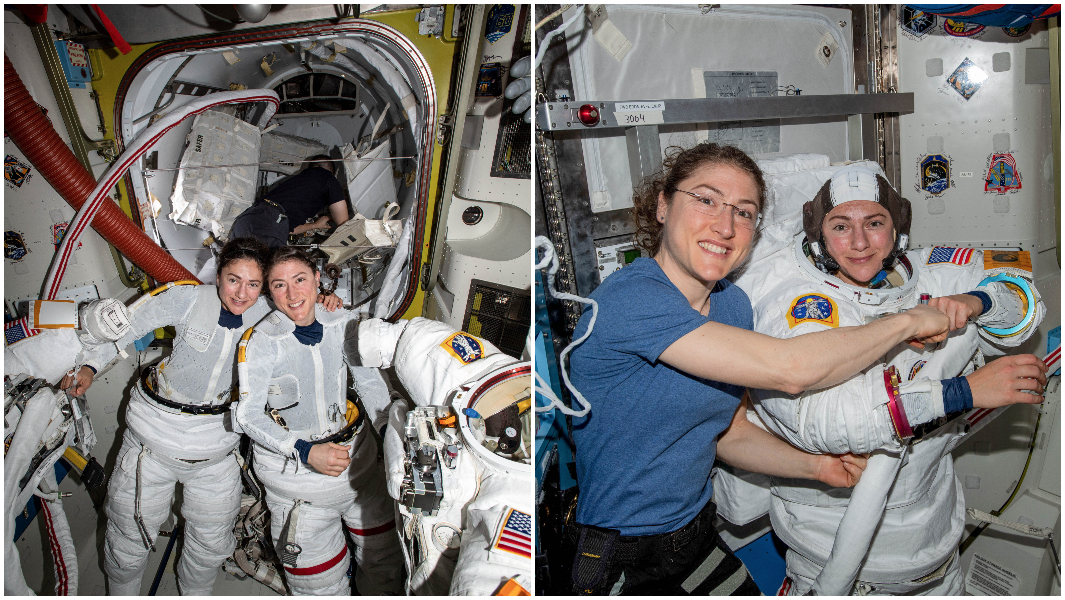Female NASA Astronauts honored for record-breaking space walk

More than 56 years after Russian astronaut Valentina Tereshkova became the first woman in space, American astronauts Christina Koch and Jessica Meir made history for NASA when they completed the first all-female spacewalk on October 18, 2019.
While Koch and Meir are the 13th and 14th US women, respectively to complete a spacewalk, the two made history for being the first all-female crew to do so. In fact, they then conducted two more spacewalks together, completing the first three all-female spacewalks.
Congrats to @NASA astronauts @Astro_Christina and @Astro_Jessica on making history and entering the #GWR2021 edition!
— GuinnessWorldRecords (@GWR) October 19, 2020
Between the two empowering spacewomen, they have broken records for:
🪐First all-female spacewalk
🪐Longest single spaceflight by a woman - @Astro_Christinapic.twitter.com/a0FjqaoJGs

Then, on February 6, 2020, Christina Koch also broke the record for the longest single spaceflight by a woman in 328 days.
In honor of the of first all-women spacewalk, Adjudicator Kaitlin Vesper presented Koch and Meir with their official certificates and to announce they are also featured in the newest Guinness World Records 2021 edition.
Originally, Koch was scheduled for the record-breaking spacewalk with astronaut Anne McClain in March 2019. After her first spacewalk, McClain recommended swapping spacewalking assignments so she could use the suit that fit her best in space, which was different than her experience training on Earth, without delaying the scheduled spacewalks.
During summer 2019, the astronauts had time to reconfigure the spacesuits on the International Space Station to two mediums, which were available to Koch and Meir on their mission.

During the spacewalk, their mission was to replace a faulty battery charge/discharge unit (BCDU) that failed to activate following installation of new lithium-ion batteries on the space station’s exterior structure.
The BCDUs regulate the amount of charge put into the batteries that collect energy from the station’s acre of solar arrays to power station systems during periods when the station orbits during nighttime passes around Earth. Did you know the space station travels through 16 sunrises and sunsets every 24 hours as it orbits Earth about every 90 minutes?
Though the BCDU failure had not impacted station operations or crew safety, it did prevent the new batteries from providing increased station power.
Similarly, Koch said she wants her record for the longest spaceflight to be broken as soon as possible, “because that means NASA is continuing to push the boundaries, and we’re continuing to explore.”
The astronauts spent seven hours and 23 minutes outside the International Space Station. Both women see their historic mission as a feat larger than themselves.
Women are still a minority of the space program’s roster since the first six female astronauts joined the program in 1978, although the most recent NASA astronaut groups selected back in 2013 and 2017 have almost an even gender split, and the ratio for the next two years is likely to shift again with more female astronauts.

After describing the record-breaking spacewalk as an “organizational achievement,” both Koch and Meir agreed this opportunity was part of their “responsibility to continue to inspire and continue to motivate the next generation of explorers to do great things.”
Even though these two made history with their record, there is still work to be done in the space program.
The two women hope to be heroes to future explorers, as well as making the space program, and its accomplishments, more diverse.



